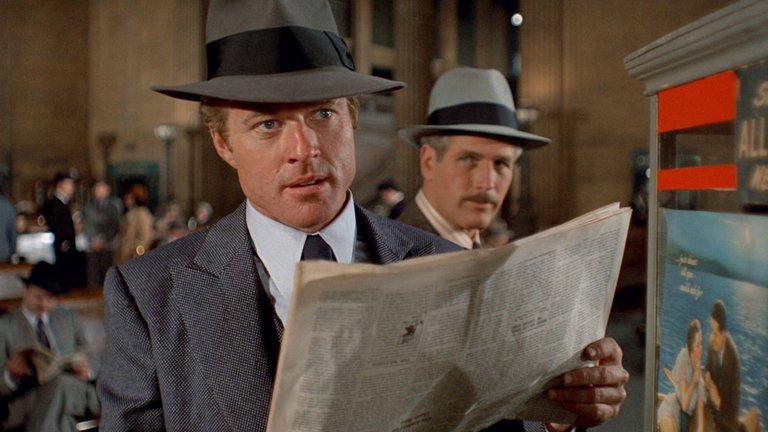Film Review: The Sting (1973)

In an era where multiplexes are glutted with infantilised CGI spectacles and Academy voters increasingly reward films preaching progressive moralism over crowd-pleasing craft, the notion of a mainstream box-office titan sweeping the Oscars feels almost quaint. Rewind to 1973, however, and one finds George Roy Hill’s The Sting—a film that conquered both global audiences and the Academy with equal panache, winning seven Oscars including Best Picture. Yet, for all its success, it remains an anomaly within the New Hollywood canon. While the decade’s cinema is synonymous with gritty, existential dirges like The Godfather or Chinatown, The Sting stands apart as a buoyant, nostalgia-soaked caper, its sepia-toned escapism clashing with the era’s prevailing nihilism. This dissonance, far from diminishing its appeal, underscores its peculiar charm—a throwback to classical Hollywood artifice in an age of radical introspection.
The film’s origins are as unconventional as its tone. David S. Ward’s Oscar-winning screenplay drew inspiration not from a novel or play, but from The Big Con (1940), an anthropological study by David W. Maurer. A linguist fascinated by underworld argot, Maurer embedded himself with Depression-era grifters, documenting their elaborate schemes with clinical precision. His book became a bible for Ward, who fictionalised its accounts of “the big store”—a meticulously staged fake betting parlour designed to fleece marks. Yet this adaptation proved contentious: Universal Pictures faced a lawsuit alleging Maurer’s estate had been sidelined in crediting the source material. The studio settled out of court, a footnote that lingers over the film’s otherwise pristine reputation.
Set against the bleak backdrop of 1936 Illinois, the narrative orbits Johnny Hooker (Robert Redford), a cocky small-time swindler whose botched grunt against a low-level courier unwittingly targets Doyle Lonnegan (Robert Shaw), a sadistic Irish mobster. When Lonnegan orders the murder of Hooker’s mentor Luther Coleman (Robert Earl Jones), the young conman flees to Chicago, seeking vengeance through an audacious “long con”. Enter Henry Gondorff (Paul Newman), a washed-up grifter drowning in bourbon and self-pity in a brothel. Reluctantly coaxed into orchestrating Lonnegan’s downfall, Gondorff assembles a ragtag crew to execute an intricate scheme exploiting the gangster’s weakness for horse racing. The plot thickens with FBI agent Polk (Dana Elcar) blackmailing Hooker and Lonnegan’s hitmen in pursuit. Ward’s script is a Swiss watch of twists, each revelation—Hooker’s feigned death, Polk’s covert alliance with Gondorff—propelling the audience toward a finale where loyalty and betrayal blur deliciously.
Ward’s Oscar victory was no fluke. The script’s genius lies in its economy: within minutes, viewers are immersed in the grubby realism of Depression-era Joliet. The labyrinthine plot, involving double-crosses, forged documents, and a fake FBI sting, could easily have collapsed under its own complexity. Yet Ward ensures clarity through sharp dialogue and disciplined pacing. The third-act rug-pull remains a masterstroke—a cascade of payoffs that feels earned rather than contrived.
George Roy Hill, often overshadowed by peers like Coppola or Scorsese, embraced a classical sensibility antithetical to New Hollywood’s avant-garde tendencies. Eschewing location shooting for Universal’s backlots, he resurrected 1930s Chicago through matte paintings and Edith Head’s exquisitely tailored costumes—pinstripe suits and cloche hats evoking Grant Wood-esque Americana. The film’s division into “acts”, punctuated by Saturday Evening Post-style title cards, nods to vintage pulp serials, while Marvin Hamlisch’s ragtime score (built on Scott Joplin melodies) injects jaunty irreverence. Critics carped about historical accuracy—Joplin’s music was passé by the 1930s—but Hill’s gambit worked: “The Entertainer” topped charts, reviving interest in Joplin and proving anachronism no barrier to emotional resonance.
While Hill’s reunion of Newman and Redford (fresh from Butch Cassidy and the Sundance Kid) undoubtedly fuelled hype, The Sting is no mere star vehicle. Newman, gruff and world-weary, doesn’t appear until relatively late in the film, while Redford’s Hooker is less the suave antihero than a brash upstart in over his head. The film’s soul lies in its supporting cast: Robert Earl Jones (father of James Earl Jones) brings gravitas to doomed mentor Luther; Charles Durning’s corrupt cop Snyder snarls with petty malice; and Harold Gould, as Gondorff’s sardonic accomplice Kid Twist, steals scenes with deadpan wit. Even Lonnegan’s henchmen, from the hulking Floyd (John Heffernan) to the weaselly Mottola (James Sloyan), are sketched with specificity.
In a post-Bonnie and Clyde landscape, The Sting’s cheerful amorality is striking. Hooker and Gondorff are unrepentant crooks, yet the film positions them as Robin Hood figures—stealing from a murderers and bigots while outsmarting venal cops. Violence, when it occurs, is swift and unglamorous: Luther’s offscreen death, Snyder’s brutal interrogation of Hooker. This moral flexibility resonated with 1970s audiences steeped in anti-establishment cynicism, offering catharsis through the conmen’s triumph over both mobsters and a corrupt system.
If the film falters, it’s in its token gestures toward convention. The subplot involving Hooker’s romance with waitress Loretta (Dimitra Arliss) feels perfunctory. Similarly, the final twist—Gondorff’s faked death—edges perilously close to schmaltz, though Newman’s gruff delivery salvages it. Yet these are quibbles. For a studio product of its time, The Sting achieves near-flawless synthesis of style and substance.
Hollywood’s itch to capitalise birthed 1983’s The Sting II, swapping Newman and Redford for Jackie Gleason and Mac Davis in a woeful farce. Its failure only burnished the original’s legend. Today, The Sting endures not just as entertainment but as a testament to pre-digital craftsmanship—a film where every tailored waistcoat, every piano riff, every sly grin conspires to remind us that cinema, at its best, is the ultimate con: making artifice feel like magic.
RATING: 9/10 (++++)
Blog in Croatian https://draxblog.com
Blog in English https://draxreview.wordpress.com/
InLeo blog https://inleo.io/@drax.leo
Hiveonboard: https://hiveonboard.com?ref=drax
InLeo: https://inleo.io/signup?referral=drax.leo
Rising Star game: https://www.risingstargame.com?referrer=drax
1Inch: https://1inch.exchange/#/r/0x83823d8CCB74F828148258BB4457642124b1328e
BTC donations: 1EWxiMiP6iiG9rger3NuUSd6HByaxQWafG
ETH donations: 0xB305F144323b99e6f8b1d66f5D7DE78B498C32A7
BCH donations: qpvxw0jax79lhmvlgcldkzpqanf03r9cjv8y6gtmk9
Posted Using INLEO